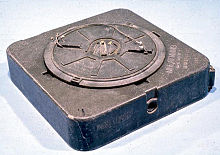Minimum metal mine

A minimum metal mine is a
Examples

Early examples included the German Glasmine 43, Schu-mine 42 and Topfmine used during World War II. These designs were either difficult or impossible to find using 1940s metal detectors.
Many different types of minimum metal mines have been produced in various countries over the years. Relatively modern examples include the antitank mines M19 (United States, less than 3g of metal) and TMA-3 (Serbia, no metal) and the anti-personnel mines PRB M-409 (Belgium, less than 1g) and the PMA-2 or PMA-3 Serbia, (approx 1g non-magnetic) and VS-50 (Italy). Since the 1970s and until 1993 (when the country enacted a national landmines manufacturing ban, four years before signing the Ottawa Treaty) Italy became a world leader in the manufacture of minimum metal mines; the three main Italian landmine manufacturers were mostly producing minimum-metal mines by the early 1980s. Valsella Meccanotecnica SpA manufactured the VS-50 and VS-Mk2. Misar SpA produced the SB-81 and SB-33, and Tecnovar Italiana SpA produced the TS-50, TC/3.6 and TC/6 mines.
Non-metallic mines
Though rare, a few land mine designs (both anti-tank and anti-personnel) contain no metal whatsoever.
See also
- Anti-handling device
- Blast resistant mine
- List of land mines (provides extensive details of various designs)
References
- ISBN 9781564321138.
- ISBN 0-8330-3301-8. MR-1608. Retrieved 19 March 2019.
- S2CID 62646469.
- ^ Jane's Mines and Mine Clearance. Jane's Information Groupt. 20 July 2011. Archived from the original on 1 October 2012. Retrieved 21 March 2019.
